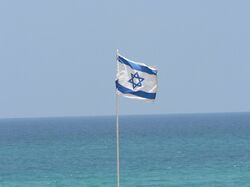Blue in Judaism


Blue in Judaism is used to symbolise divinity, because blue is the color of the sky and sea. It can also represent equilibrium, since its hue suggests a shade midway between white and black, day and evening.[1]
History
From ancient times, blue has been considered a lucky color among the peoples of the Middle East and North Africa. Not unlike their Arab neighbors, Jews of this region have painted their doorposts, heads, and other parts of their bodies with blue dyes; have ornamented their children with blue ribbons and markings; and have used this color in protective amulets.[2] Blue has been considered especially effective against the evil eye.
In the Torah, the Israelites were commanded to make tassels, tzitzit, on the corners of their garments, and to weave within these tassles a "twisted thread of blue-violet (Tekhelet)."[3] The oral law requires that this blue thread be made from a dye extracted from a sea creature known in rabbinic literature as the Ḥilazon. Maimonides claimed that this blue was the color of "the clear noonday sky"; Rashi, the color of the evening sky.[4]
According to several rabbinic sages, blue is the color of God's Glory.[5] Staring at this color aids in meditation, bringing us a glimpse of the "pavement of sapphire, like the very sky for purity," which is a likeness of the Throne of God.[6] Many items in the Mishkan, the portable sanctuary in the wilderness, such as the menorah, many of the vessels, and the Ark of the Covenant, were covered with blue-violet cloth when transported from place to place.[7]
According to the Zohar all colors that one sees in their dream are a good sign, except if they see the shade of blue that matches Tekhelet.[8]
In modern times
The Flag of Israel has two blue stripes and a blue Star of David against a white background. An early Zionist poem explains that the color white symbolizes great faith; blue the appearance of the firmament.[9] Because of its association with the State of Israel, blue has become very popular in contemporary Jewish design. Modern tallitot, especially those used by Religious Zionist Jews, often have blue stripes on a white background instead of black stripes common in Haredi communities.
See also
- Green in Islam
- Jewish symbolism
- Jewish symbolism § Colors
- Political colour
References
- ↑ Mishnah Zeraim 1:2
- ↑ Frankel, Ellen; Teutsch, Betsy Platkin (1992) (in en). The Encyclopedia of Jewish Symbols. Rowman & Littlefield. ISBN 9780876685945. https://books.google.com/books?id=PASL_g8JDqsC&pg=PA22&lpg=PA22&dq=doorposts,+heads,+and+other+parts+of+their+bodies&source=bl&ots=RbX32zKxtR&sig=Q10UDHTAjzoDMHmMaBbej_YCzbw&hl=en&sa=X&ved=2ahUKEwjXo6Sc8vPcAhWOxYUKHSJeDKUQ6AEwA3oECBsQAQ#v=onepage&q=doorposts%252C%2520heads%252C%2520and%2520other%2520parts%2520of%2520their%2520bodies&f=false.
- ↑ Numbers 15:38.
- ↑ Mishneh Torah, Tzitzit 2:1; Commentary on Numbers 15:38.
- ↑ Numbers Rabbah 14:3; Hullin 89a.
- ↑ Exodus 24:10; Ezekiel 1:26; Hullin 89a.
- ↑ Numbers 4:6-12. None of the leading poskim, such as Rabbi Chaim Kanievsky have given their approval to the claims of the Ptil Tekhelet organisation. Many famous Jewish sages such as the Chazon Ish have maintained that the real colour will be rediscovered at certain time in human history. See "The Twelfth Article of Faith" by Maimonides.
- ↑ Zohar I 51b
- ↑ "Zivei Eretz Yehudah" (1860), Ludwig August von Frankl.
Further reading
- Zvi Ruder (1999): The National Colors of the People of Israel: Tradition, Religion, Philosophy, and Politics Intertwined ISBN:965-293-059-8
External links
- The Ptil Tekhelet Organization dedicated to the manufacture and distribution of tekhelet fringes.


